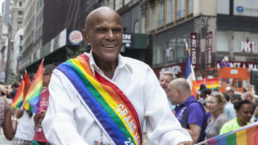This epochal artist helped us see that justice for all requires a just distribution of wealth.
By Sam Pizzigati, Inequality.org
Those of us just eight years old back in 1956 didn’t know the amazing stats of Harry Belafonte’s sudden and smashing musical success. We didn’t know, for instance, that his record album entitled Calypso had become the first album by a single artist ever to sell over a million copies. But we did know Harry Belafonte. His music and voice seemed to be coming at us from everywhere.

“Day-o!” we kids would warble. “Daylight come and we want go home.”
Belafonte, unlike other stars of that era, never did “go home” and fade away. On Tuesday, right after his death, almost every major U.S. media outlet immediately began running glowing appreciations of his long and remarkable career. The obituaries all saluted his artistry and his commitment to social justice.
From the late 1950s onward, as the New York Times obit would note, Belafonte would be far more than a superstar. Year after year, he put “his primary focus” on “civil rights,” the “quest for racial equality,” doing everything from bailing out jailed activists to helping organize the landmark 1963 March on Washington.
But both Belafonte and his close friend Martin Luther King Jr saw their civil rights advocacy as the cutting edge of a still broader struggle for equality. At one activist gathering in Belafonte’s New York apartment, his memoir My Song would later relate, the assembled activists heard Dr. King give that broader struggle an evocative frame.
“I’ve come to believe,” the Rev. Dr. King told the group, “that we are integrating into a burning house.”
Recent Posts
U.S. Realizes It Can Seize Boats After All
December 11, 2025
Take Action Now After months of extrajudicial killings in the waters off Venezuela, the Trump administration opted instead to capture an oil tanker.……
Wrong voters, wrong message: progressives’ autopsy lays bare Kamala Harris failures
December 10, 2025
Take Action Now RootsAction report finds Harris courted moderates instead of working-class Democrats – and Gaza stance did not helpBy David Smith,…
Senate GOP Healthcare Plan Decried as ‘Utter Joke’ That Would Devastate Sick Americans
December 10, 2025
Take Action Now One campaigner said Republicans want to force people “onto junk plans that leave them at risk of crippling medical debt.”By Jake…
We Need To Know How Corporate Democrats Made President Trump Possible
December 9, 2025
Take Action Now Saving the country from autocracy requires recognizing and overcoming the chokehold that Democratic leaders have on the party.By…




